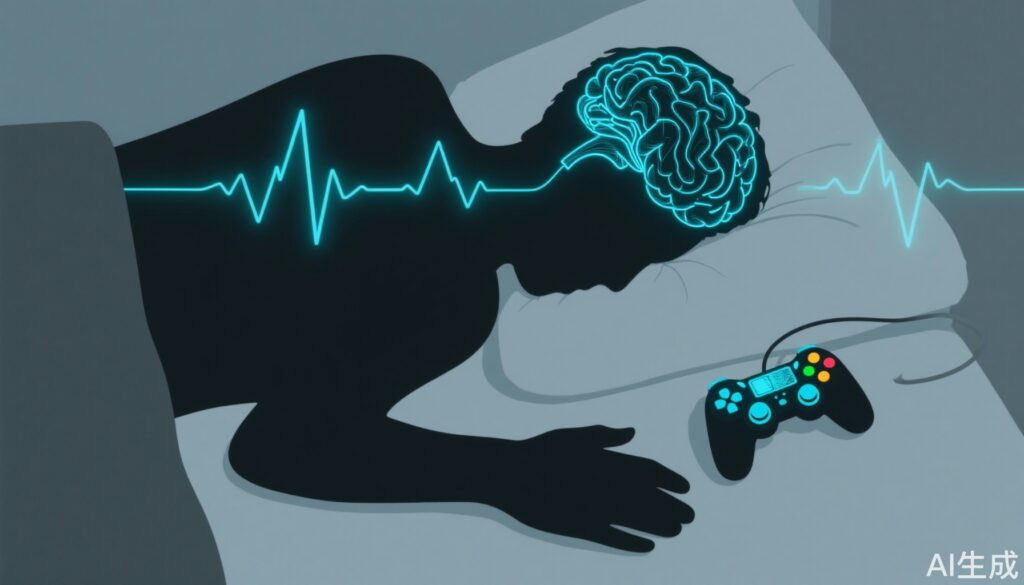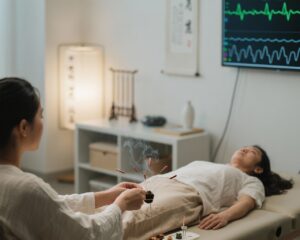Highlight
– Closed-loop auditory cue exposure during slow-wave sleep (SWS) significantly reduces cravings and game playtime in Internet Gaming Disorder (IGD).
– Sleep intervention modulates late spindle power, correlated with craving reduction.
– Awake cue exposure therapy shows no significant benefit in IGD.
– Closed-loop auditory exposure during SWS represents a promising non-pharmacological, non-invasive intervention for IGD.
Study Background and Disease Burden
Internet Gaming Disorder (IGD), characterized by excessive and compulsive engagement in online gaming, is associated with significant psychological distress and impaired social functioning. Despite its recognition as a behavioral addiction, IGD lacks effective clinical treatments, posing an unmet medical need. Traditional cue exposure therapy (CET), aimed at extinguishing maladaptive addictive memories by repeated exposure to game-related stimuli during wakefulness, has shown limited success. Recent neuroscientific advances identify sleep, particularly slow-wave sleep (SWS), as a critical period for memory consolidation and modulation. Leveraging sleep’s unique neurophysiological milieu may enable novel strategies to attenuate the reinforcing memory traces driving IGD behaviors.
Study Design
This randomized controlled study enrolled 84 participants diagnosed with IGD according to DSM-5 criteria. Participants were allocated to one of four groups: Sleep Intervention Group (SIG), Sleep Control Group (SCG), Awake Intervention Group (AIG), and Awake Control Group (ACG). Interventions occurred over two consecutive days. The SIG received approximately 300 game-related auditory cues delivered during the UP-phase of slow-wave oscillations across two intervention nights. The awake groups (AIG and ACG) underwent comparable cue exposure while awake. The primary outcomes measured were craving intensity and daily playtime, assessed at baseline, immediately post-intervention, and at follow-ups over one month (weeks 1, 2, 3 and at one month). Additionally, electrophysiological measures included P300 amplitude in a cue reactivity task and sleep spindle power (early and late periods) from EEG during intervention nights.
Key Findings
The Sleep Intervention Group (SIG) demonstrated statistically significant reductions in craving (p < 0.001) and average daily playtime (p = 0.009) both immediately after the intervention and throughout follow-up compared with control groups. In contrast, the awake CET groups exhibited no significant improvement in these parameters.
Physiological analyses revealed that auditory cue exposure during SWS increased low-frequency and early spindle power but reduced late spindle power post-exposure. Notably, there was a progressive linear increase in sound-elicited late spindle power across twenty blocks of intervention across the two nights, which positively correlated with the reduction in craving intensity post-intervention (r = 0.54, p = 0.015). This correlation was especially pronounced among participants showing over 30% craving reduction one month after the intervention.
The P300 amplitude, a neural marker of cue reactivity, also reflected this attenuation of gaming-related cognitive-emotional processing in the SIG group, suggesting reduced salience of gaming cues.
Expert Commentary
The study illuminates the potential of targeting memory reconsolidation processes during sleep via closed-loop auditory stimulation. Sleep spindles—bursts of oscillatory brain activity—are implicated in synaptic plasticity and memory integration. Modulation of late spindle power may represent neural plasticity mechanisms underlying the weakening of maladaptive gaming memories. These findings also raise important questions about the timing and specificity of cue exposure interventions.
While promising, this novel approach requires replication in larger and more diverse IGD populations. Additionally, the long-term durability beyond one month and effects on psychosocial functioning warrant further investigation. An important consideration is the precision of cue timing relative to slow oscillation phases, which remains technically challenging in broader clinical settings.
Conclusion
Repeated closed-loop auditory exposure during slow-wave sleep emerges as a promising, non-invasive intervention that reduces cravings and gaming behavior in individuals with Internet Gaming Disorder. By modulating sleep spindle power, this approach harnesses endogenous memory consolidation mechanisms, offering a transformative direction for IGD treatment beyond awake cue exposure therapies. Further research should explore optimization, generalizability, and integration into comprehensive treatment programs.
References
Yang X, Song Y, Liu W, Huang Y, Jia T, Liu J, Lu L, Sun Y, Shi J. Efficacy and mechanisms of repeated closed-loop auditory exposure during slow-wave sleep for internet gaming disorder. Mol Psychiatry. 2025 Sep;30(9):4151-4160. doi: 10.1038/s41380-025-02995-1. Epub 2025 May 27. PMID: 40425853; PMCID: PMC12339371.


